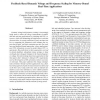14 search results - page 2 / 3 » Reducing Memory Latency via Read-after-Read Memory Dependenc... |
ICS
2003
Tsinghua U.
13 years 10 months ago
2003
Tsinghua U.
—The ever-increasing computational power of contemporary microprocessors reduces the execution time spent on arithmetic computations (i.e., the computations not involving slow me...
RTAS
2005
IEEE
13 years 11 months ago
2005
IEEE
Dynamic voltage and frequency scaling is increasingly being used to reduce the energy requirements of embedded and real-time applications by exploiting idle CPU resources, while s...
ICS
1998
Tsinghua U.
13 years 9 months ago
1998
Tsinghua U.
In order to achieve high performance, contemporary microprocessors must effectively process the four major instruction types: ALU, branch, load, and store instructions. This paper...
MICRO
1998
IEEE
13 years 9 months ago
1998
IEEE
Load latency remains a significant bottleneck in dynamically scheduled pipelined processors. Load speculation techniques have been proposed to reduce this latency. Dependence Pred...
JILP
2000
13 years 5 months ago
2000
Load latency remains a signi cant bottleneck in dynamically scheduled pipelined processors. Load speculation techniques have been proposed to reduce this latency. Dependence Predi...

